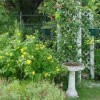 This 17-page fact sheet provides useful resources and handy tables for information on the function, form, and landscape use of proven native performers of the Florida Treasure Coast (Martin, St. Lucie, and Indian River Counties). Written by Sandra B. Wilson, Judith A. Gersony, Keona L. Nolan, Janice C. Broda, and Edward A. Skvarch, Jr., and published by the UF Department of Environmental Horticulture, March 2013.
This 17-page fact sheet provides useful resources and handy tables for information on the function, form, and landscape use of proven native performers of the Florida Treasure Coast (Martin, St. Lucie, and Indian River Counties). Written by Sandra B. Wilson, Judith A. Gersony, Keona L. Nolan, Janice C. Broda, and Edward A. Skvarch, Jr., and published by the UF Department of Environmental Horticulture, March 2013.
http://edis.ifas.ufl.edu/ep348
Tag: Environmental Horticulture Department
Uso Apropiado y Manipulacion de Glifosato en Viveros de Plantas (ENH1209/EP470)
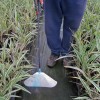 El glifosato es el químico de protección para cultivos más vendido en el mundo y el herbicida mós usado en la industria de viveros de plantas en los Estados Unidos. El glifosato es usado para el control post emergente de malezas. Esta publicación describe el uso adecuado de glifosato para los productores de plantas y sus empleados. This 4-page fact sheet was written by Shawn T. Steed, Robert H. Stamps, and Rodrigo Diaz, and published by the UF Department of Environmental Horticulture, February 2013.
El glifosato es el químico de protección para cultivos más vendido en el mundo y el herbicida mós usado en la industria de viveros de plantas en los Estados Unidos. El glifosato es usado para el control post emergente de malezas. Esta publicación describe el uso adecuado de glifosato para los productores de plantas y sus empleados. This 4-page fact sheet was written by Shawn T. Steed, Robert H. Stamps, and Rodrigo Diaz, and published by the UF Department of Environmental Horticulture, February 2013.
http://edis.ifas.ufl.edu/ep470
Ornamental Palms for Central Florida (ENH60/EP020)
 Palms are often thought of as symbols of the tropics, but fortunately there are a number of palm species that grow in warm, temperate climates, such as that of Central Florida. This 8-page fact sheet was written by Timothy K. Broschat and James E. Davis, and published by the UF Department of Environmental Horticulture, January 2013.
Palms are often thought of as symbols of the tropics, but fortunately there are a number of palm species that grow in warm, temperate climates, such as that of Central Florida. This 8-page fact sheet was written by Timothy K. Broschat and James E. Davis, and published by the UF Department of Environmental Horticulture, January 2013.
http://edis.ifas.ufl.edu/ep020
Design and Implementation of Edible Plant Demonstration Gardens: A Case Study of the Putnam County Extension Edible Garden (ENH1205/EP466)
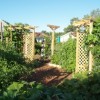 Demonstration gardens are a collection of plants assembled and organized in a manner that allows garden visitors to access and study them. Most gardens are designed with a particular focus and include plants that support the purpose and educational theme of the garden. This case study features an edible plant demonstration garden that was designed and installed in Hastings, Florida, on the Extension office grounds. The UF/IFAS program and the Partnership for Water, Agriculture, and Community Sustainability (FPWACS) designed and implemented the demonstration garden using a step-by-step process that is discussed in this 15-page fact sheet written by Gail Hansen, Joseph Sewards, Rebecca Almeida, and Andrew Dunn, and published by the UF Department of Environmental Horticulture, November 2012.
Demonstration gardens are a collection of plants assembled and organized in a manner that allows garden visitors to access and study them. Most gardens are designed with a particular focus and include plants that support the purpose and educational theme of the garden. This case study features an edible plant demonstration garden that was designed and installed in Hastings, Florida, on the Extension office grounds. The UF/IFAS program and the Partnership for Water, Agriculture, and Community Sustainability (FPWACS) designed and implemented the demonstration garden using a step-by-step process that is discussed in this 15-page fact sheet written by Gail Hansen, Joseph Sewards, Rebecca Almeida, and Andrew Dunn, and published by the UF Department of Environmental Horticulture, November 2012.
http://edis.ifas.ufl.edu/ep466
New Hydrangeas for North and Central Florida: Bigleaf and Mountain Hydrangeas (ENH1034/EP287)
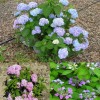 Discoveries of reflowering hydrangeas have resulted in the introduction of many new cultivars, providing more garden impact and strengthening ongoing hydrangea appreciation. Even prior to the new reflowering cultivars, gardeners and landscapers had renewed interest in hydrangeas because they flower in shade, often produce blue flowers, and are considered an “heirloom” plant that reminds us of the garden heritage of our forefathers. Many of the newer cultivars have superior form and disease resistance, and some provide 15 or more weeks of flowering per year in north Florida. This 5-page fact sheet was written by Gary W. Knox, and published by the UF Department of Environmental Horticulture, September 2012.
Discoveries of reflowering hydrangeas have resulted in the introduction of many new cultivars, providing more garden impact and strengthening ongoing hydrangea appreciation. Even prior to the new reflowering cultivars, gardeners and landscapers had renewed interest in hydrangeas because they flower in shade, often produce blue flowers, and are considered an “heirloom” plant that reminds us of the garden heritage of our forefathers. Many of the newer cultivars have superior form and disease resistance, and some provide 15 or more weeks of flowering per year in north Florida. This 5-page fact sheet was written by Gary W. Knox, and published by the UF Department of Environmental Horticulture, September 2012.
http://edis.ifas.ufl.edu/ep287
Hurricane-Damaged Palms in the Landscape: Care after the Storm (ENH1204/EP465)
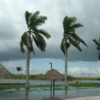 While many palm species are adapted to windstorms, a hurricane can damage even the most tolerant palms. This 3-page fact sheet provides suggestions about what to do after a windstorm has occurred once it is safe to venture outside to care for the landscape.
While many palm species are adapted to windstorms, a hurricane can damage even the most tolerant palms. This 3-page fact sheet provides suggestions about what to do after a windstorm has occurred once it is safe to venture outside to care for the landscape.
Written by Monica L. Elliott and Timothy Broschat, and published by the UF Department of Environmental Horticulture, September 2012.
http://edis.ifas.ufl.edu/ep465
Alternatives to Synthetic Herbicides for Weed Management in Container Nurseries (ENH1203/EP464)
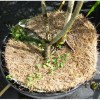 Weed management is one of the most critical and costly aspects of container nursery production. This is most effectively achieved through preventative practices, primarily with preemergent herbicides. But there are valid reasons for managing weeds with alternatives to synthetic herbicides, including sanitation, exclusion, prevention, hand weeding, mulching, and the use of cover crops, heat, and nonsynthetic herbicides. This 6-page fact sheet was written by Gary W. Knox, Matthew Chappell, and Robert H. Stamps, and published by the UF Department of Environmental Horticulture, September 2012.
Weed management is one of the most critical and costly aspects of container nursery production. This is most effectively achieved through preventative practices, primarily with preemergent herbicides. But there are valid reasons for managing weeds with alternatives to synthetic herbicides, including sanitation, exclusion, prevention, hand weeding, mulching, and the use of cover crops, heat, and nonsynthetic herbicides. This 6-page fact sheet was written by Gary W. Knox, Matthew Chappell, and Robert H. Stamps, and published by the UF Department of Environmental Horticulture, September 2012.
http://edis.ifas.ufl.edu/ep464
UF-T3 and UF-T4: Two Sterile Lantana camara Varieties (ENH1202/EP463)
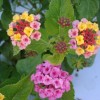 Lantana camara plants are valued for their bright flower color, butterfly attraction, tolerance to harsh environmental conditions, low maintenance requirements, and ease of propagation and production. But many existing varieties can be weedy or invasive when grown in tropical and subtropical regions. So in 2004, UF/IFAS started a program to develop sterile L. camara varieties with little to no invasive potential.
Lantana camara plants are valued for their bright flower color, butterfly attraction, tolerance to harsh environmental conditions, low maintenance requirements, and ease of propagation and production. But many existing varieties can be weedy or invasive when grown in tropical and subtropical regions. So in 2004, UF/IFAS started a program to develop sterile L. camara varieties with little to no invasive potential.
This 8-page fact sheet introduces the recently released UF-T3 and UF-T4 lantana varieties that have resulted from these breeding, selection, and testing efforts. Written by Zhanao Deng, David M. Czarnecki II, Sandra B. Wilson, Gary W. Knox, and Rosanna Freyre, and published by the UF Department of Environmental Horticulture, August 2012.
http://edis.ifas.ufl.edu/ep463
Design Considerations for a Florida-Friendly Demonstration Landscape: A Case Study for Student and Extension Volunteer Involvement (ENH1199/EP460)
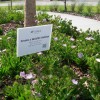 Landscape design students in the Environmental Horticulture Department at the University of Florida participated in the planning and design of the landscape for a new professional development center on the university campus. Such large-scale projects provide a unique experiential learning activity for students and volunteers in landscape design and horticulture programs. This 6-page fact sheet was written by Gail Hansen and Brian Niemann, and published by the UF Department of Environmental Horticulture, August 2012.
Landscape design students in the Environmental Horticulture Department at the University of Florida participated in the planning and design of the landscape for a new professional development center on the university campus. Such large-scale projects provide a unique experiential learning activity for students and volunteers in landscape design and horticulture programs. This 6-page fact sheet was written by Gail Hansen and Brian Niemann, and published by the UF Department of Environmental Horticulture, August 2012.
http://edis.ifas.ufl.edu/ep460
'Strawberry Star': A Spotted, Fancy-Leaved Caladium for Use in Containers and Landscapes (ENH1201/EP462)
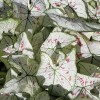 'Strawberry Star' is a fancy-leaved variety with a primarily white leaf face and attractive red spots. It is similar to 'Marie Moir' in leaf color and coloration pattern but different from 'Marie Moir' in petiole color. Compared to 'Marie Moir', 'Strawberry Star' sprouts earlier, produces high-quality container plants, demonstrates better landscape performance, and yields more tubers. These improvements make 'Strawberry Star' a desirable replacement for 'Marie Moir' and an additional sun-tolerant variety for the landscape plant palette. This 5-page fact sheet was written by Zhanao Deng, and published by the UF Department of Environmental Horticulture, August 2012.
'Strawberry Star' is a fancy-leaved variety with a primarily white leaf face and attractive red spots. It is similar to 'Marie Moir' in leaf color and coloration pattern but different from 'Marie Moir' in petiole color. Compared to 'Marie Moir', 'Strawberry Star' sprouts earlier, produces high-quality container plants, demonstrates better landscape performance, and yields more tubers. These improvements make 'Strawberry Star' a desirable replacement for 'Marie Moir' and an additional sun-tolerant variety for the landscape plant palette. This 5-page fact sheet was written by Zhanao Deng, and published by the UF Department of Environmental Horticulture, August 2012.
http://edis.ifas.ufl.edu/ep462
'Summer Pink': A New Pink, Fancy-Leaved Caladium Variety (ENH1200/EP461)
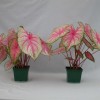 ‘Summer Pink’ is a new fancy-leaved caladium variety developed by the University of Florida’s Institute of Food and Agricultural Sciences (UF/IFAS) caladium breeding program for use in large containers and shady locations in the landscape (Deng and Harbaugh 2012). Leaves of this variety have a pink face and pink veins. In replicated field and greenhouse trials, ‘Summer Pink’ performed comparably or better than ‘Fannie Munson’ and ‘White Queen’, two pink caladium varieties commonly used in containers and landscapes. This 4-page fact sheet was written by Zhanao Deng, and published by the UF Department of Environmental Horticulture, August 2012.
‘Summer Pink’ is a new fancy-leaved caladium variety developed by the University of Florida’s Institute of Food and Agricultural Sciences (UF/IFAS) caladium breeding program for use in large containers and shady locations in the landscape (Deng and Harbaugh 2012). Leaves of this variety have a pink face and pink veins. In replicated field and greenhouse trials, ‘Summer Pink’ performed comparably or better than ‘Fannie Munson’ and ‘White Queen’, two pink caladium varieties commonly used in containers and landscapes. This 4-page fact sheet was written by Zhanao Deng, and published by the UF Department of Environmental Horticulture, August 2012.
http://edis.ifas.ufl.edu/ep461
Measuring the Irrigation Requirement of Container-Grown Nursery Plants (ENH1197/EP458)
 Three factors determine the irrigation requirement for container-grown crops: evapotranspiration, capture factor, and distribution uniformity. This 4-page fact sheet describes how these factors can be measured so that irrigation requirements can be determined in the container nursery. Written by Jeff Million and Tom Yeager, and published by the UF Department of Environmental Horticulture, June 2012.
Three factors determine the irrigation requirement for container-grown crops: evapotranspiration, capture factor, and distribution uniformity. This 4-page fact sheet describes how these factors can be measured so that irrigation requirements can be determined in the container nursery. Written by Jeff Million and Tom Yeager, and published by the UF Department of Environmental Horticulture, June 2012.
http://edis.ifas.ufl.edu/ep458
Proper Use and Handling of Glyphosate in Plant Nurseries (ENH1198/EP459)
 Glyphosate is the most used herbicide in the nursery industry in the United States. Used for postemergent control of vegetation, it controls annual and perennial grasses, broadleaves, and sedges. But it is easy to cause unintended damage to desirable vegetation if this product is used incorrectly. This 4-page fact sheet outlines the proper use of glyphosate for plant producers and their employees. Written by Shawn T. Steed and Robert H. Stamps and published by the UF Department of Environmental Horticulture, May 2012.
Glyphosate is the most used herbicide in the nursery industry in the United States. Used for postemergent control of vegetation, it controls annual and perennial grasses, broadleaves, and sedges. But it is easy to cause unintended damage to desirable vegetation if this product is used incorrectly. This 4-page fact sheet outlines the proper use of glyphosate for plant producers and their employees. Written by Shawn T. Steed and Robert H. Stamps and published by the UF Department of Environmental Horticulture, May 2012.
http://edis.ifas.ufl.edu/ep459
Camellias at a Glance (CIR461/EP002)
 Native to Asia, the first camellia plants were brought to America in 1797 and grown in New England greenhouses. Over the last 200 years, they have proven to be dependable additions to the southern landscape, where they grow and bloom with minimal care in most inland areas of North and Central Florida. Camellias are long lived and function well as foundation plantings, screens, accent plants, background groupings, and hedges. Camellias flower in the fall and winter when few other plants are blooming. For the remainder of the year, their glossy, evergreen foliage, interesting forms and textures, relatively slow growth, and low maintenance make camellias excellent landscape plants worthy of more use. This 6-page fact sheet was written by Sydney Park Brown, and published by the UF Department of Environmental Horticulture, April 2012.
Native to Asia, the first camellia plants were brought to America in 1797 and grown in New England greenhouses. Over the last 200 years, they have proven to be dependable additions to the southern landscape, where they grow and bloom with minimal care in most inland areas of North and Central Florida. Camellias are long lived and function well as foundation plantings, screens, accent plants, background groupings, and hedges. Camellias flower in the fall and winter when few other plants are blooming. For the remainder of the year, their glossy, evergreen foliage, interesting forms and textures, relatively slow growth, and low maintenance make camellias excellent landscape plants worthy of more use. This 6-page fact sheet was written by Sydney Park Brown, and published by the UF Department of Environmental Horticulture, April 2012.
http://edis.ifas.ufl.edu/ep002
South Florida Gardening Calendar (ENH1191/EP452)
 Prune non-spring flowering shrubs and trees in January to improve form. In March, plant warm-season vegetables, such as sweet corn, cucumber, watermelon, and pepper, for late spring harvest. If bahiagrass lawns are yellowing in May, iron may correct the problem. Butterfly lily and gladiolus are bulbs that can be planted during the middle of summer. Plant gladiolus every 2 weeks in September to stagger blooming. This 11-page fact sheet tells what to plant and what to do in your south Florida garden, year-round. Written by Sydney Park Brown and published by the UF Department of Environmental Horticulture, April 2012.
Prune non-spring flowering shrubs and trees in January to improve form. In March, plant warm-season vegetables, such as sweet corn, cucumber, watermelon, and pepper, for late spring harvest. If bahiagrass lawns are yellowing in May, iron may correct the problem. Butterfly lily and gladiolus are bulbs that can be planted during the middle of summer. Plant gladiolus every 2 weeks in September to stagger blooming. This 11-page fact sheet tells what to plant and what to do in your south Florida garden, year-round. Written by Sydney Park Brown and published by the UF Department of Environmental Horticulture, April 2012.
http://edis.ifas.ufl.edu/ep452
North Florida Gardening Calendar (ENH1190/EP451)
 Give cold-damaged palms proper care to encourage their recovery in February. In April, monitor landscape plants weekly for aphids on tender new growth. Annuals that can take full sun during hot summer months include celosia, portulaca, vinca, and some coleus. In September, plant cool-season vegetable crops, such as radish, carrot, cabbage, and lettuce. This 10-page fact sheet tells what to plant and what to do in your north Florida garden year-round. Written by Sydney Park Brown, and published by the UF Department of Environmental Horticulture, April 2012.
Give cold-damaged palms proper care to encourage their recovery in February. In April, monitor landscape plants weekly for aphids on tender new growth. Annuals that can take full sun during hot summer months include celosia, portulaca, vinca, and some coleus. In September, plant cool-season vegetable crops, such as radish, carrot, cabbage, and lettuce. This 10-page fact sheet tells what to plant and what to do in your north Florida garden year-round. Written by Sydney Park Brown, and published by the UF Department of Environmental Horticulture, April 2012.
http://edis.ifas.ufl.edu/ep451
Central Florida Gardening Calendar (ENH1189/EP450)
 Apply horticultural oils in January. Plant caladium bulbs in March. Watch for thrips, scale, and mites in May. Plant palms in June and July. Calibrate your sprinklers in September. This 10-page fact sheet tells what to plant and what to do in your central Florida garden in each month of the year. Written by Sydney Park Brown, and published by the UF Department of Environmental Horticulture, April 2012.
Apply horticultural oils in January. Plant caladium bulbs in March. Watch for thrips, scale, and mites in May. Plant palms in June and July. Calibrate your sprinklers in September. This 10-page fact sheet tells what to plant and what to do in your central Florida garden in each month of the year. Written by Sydney Park Brown, and published by the UF Department of Environmental Horticulture, April 2012.
http://edis.ifas.ufl.edu/ep450
Preemergence Herbicides for Use in Ornamentals (OH94/WG058)
 Preemergence herbicides are herbicides that are applied prior to weed seed germination. Control of weeds using preemergence herbicides is most successful when the correct herbicide is applied in the correct manner to a weed-free growing medium prior to weed seed germination. This 60-page fact sheet was written by Robert H. Stamps, Heidi M. Savage, Diane K. Rock, and Jeffrey G. Norcini, and published by the UF Department of Environmental Horticulture, March 2012.
Preemergence herbicides are herbicides that are applied prior to weed seed germination. Control of weeds using preemergence herbicides is most successful when the correct herbicide is applied in the correct manner to a weed-free growing medium prior to weed seed germination. This 60-page fact sheet was written by Robert H. Stamps, Heidi M. Savage, Diane K. Rock, and Jeffrey G. Norcini, and published by the UF Department of Environmental Horticulture, March 2012.
http://edis.ifas.ufl.edu/wg058
Identification of Poison Ivy, Poison Oak, Poison Sumac, and Poisonwood (ENH886/EP220)
 Florida parks and woodlands are favorite places for many people who enjoy outdoor activities. Unfortunately, the native plants poison ivy, poison oak, poison sumac, and poisonwood can make these outings a miserable experience. All four contain urushiol, a plant oil that can cause a severe skin rash (dermatitis) when any part of the plant is contacted. Allergic reaction can occur directly by touching the plant or indirectly by coming into contact with the oil on animals, tools, clothes, shoes, or other items. Even the smoke from burning plants contains oil particles that can be inhaled and cause lung irritation. This 6-page fact sheet helps individuals learn to identify these plants in order to avoid contact with them. Children should be taught to recognize these plants, particularly poison ivy, as it is by far the most common. Written by Sydney Park Brown and Patricia Grace, and published by the UF Department of Environmental Horticulture, March 2012.
Florida parks and woodlands are favorite places for many people who enjoy outdoor activities. Unfortunately, the native plants poison ivy, poison oak, poison sumac, and poisonwood can make these outings a miserable experience. All four contain urushiol, a plant oil that can cause a severe skin rash (dermatitis) when any part of the plant is contacted. Allergic reaction can occur directly by touching the plant or indirectly by coming into contact with the oil on animals, tools, clothes, shoes, or other items. Even the smoke from burning plants contains oil particles that can be inhaled and cause lung irritation. This 6-page fact sheet helps individuals learn to identify these plants in order to avoid contact with them. Children should be taught to recognize these plants, particularly poison ivy, as it is by far the most common. Written by Sydney Park Brown and Patricia Grace, and published by the UF Department of Environmental Horticulture, March 2012.
http://edis.ifas.ufl.edu/ep220
Hollies at a Glance (ENH42/MG021)
 Hollies are reliable, low-maintenance plants for Florida landscapes. Diverse sizes, forms, and textures exist, ranging from large trees to dwarf shrubs. Some hollies can be used as informal or formal hedges or as foundation plants, while others make beautiful accent or specimen plants. Many are valued for their colorful berries, which provide food for birds and brighten the fall and winter seasons. Several hollies are native to Florida. This 5-page fact sheet includes a list of dozens of popular hollies sold in Florida. Written by Sydney Park Brown, Dewayne L. Ingram, and William E. Barrick, and published by the UF Department of Environmental Horticulture, March 2012.
Hollies are reliable, low-maintenance plants for Florida landscapes. Diverse sizes, forms, and textures exist, ranging from large trees to dwarf shrubs. Some hollies can be used as informal or formal hedges or as foundation plants, while others make beautiful accent or specimen plants. Many are valued for their colorful berries, which provide food for birds and brighten the fall and winter seasons. Several hollies are native to Florida. This 5-page fact sheet includes a list of dozens of popular hollies sold in Florida. Written by Sydney Park Brown, Dewayne L. Ingram, and William E. Barrick, and published by the UF Department of Environmental Horticulture, March 2012.
http://edis.ifas.ufl.edu/mg021